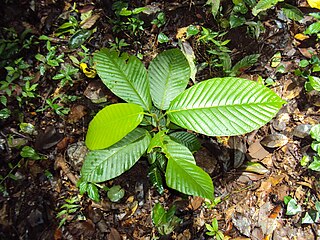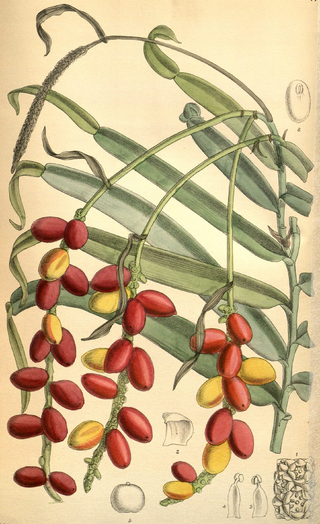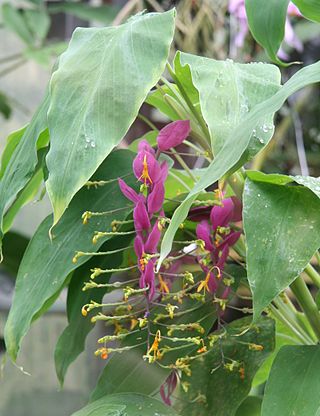
Trigonostemon is a plant genus of the family Euphorbiaceae and the sole member of its tribe (Trigonostemoneae). It was first described as a genus in 1826. It is native to Southeast Asia, southern China, the Indian Subcontinent, Queensland, and a few islands in the western Pacific.

Dimorphocalyx is a genus of plants under the family Euphorbiaceae first described as a genus in 1861. It is native to Southeast Asia, Hainan, India, Sri Lanka, New Guinea, and Queensland.

Aporosa is a genus of flowering plant belonging to the family Phyllanthaceae, first described as a genus in 1825. It is native to China, the Indian Subcontinent, Southeast Asia, Papuasia, and Queensland.

Cleistanthus is a plant genus of the family Phyllanthaceae, tribe Bridelieae, first described as a genus in 1848. It is widespread in much of the Old World Tropics in Asia, Africa, Australia, and various oceanic islands. Cleistanthus collinus is known for being toxic and may be the agent of homicides or suicides.

Drypetes is a plant genus of the family Putranjivaceae, in the order Malpighiales.

Dipterocarpus is a genus of flowering plants and the type genus of family Dipterocarpaceae.

Daemonorops was a genus of rattan palms in the family Arecaceae. Its species are now included within the genus Calamus. Species now placed in Daemonorops are dioecious, with male and female flowers on separate individuals. They are found primarily in the tropics and subtropics of southeastern Asia with a few species extending into southern China and the Himalayas.

Hanguana is a genus of flowering plants with a dozen known species. It is the only genus in the family Hanguanaceae.

Chionanthus, common name: fringetrees, is a genus of about 140 species of flowering plants in the family Oleaceae.

Megacorma obliqua, the black-belted hawkmoth, is a moth of the family Sphingidae.

Pothos is a genus of flowering plants in the family Araceae. It is native to China, the Indian Subcontinent, Australia, New Guinea, Southeast Asia, and various islands of the Pacific and Indian Oceans.

Alseodaphne is a genus of plants in the family Lauraceae, endemic to China and Southeast Asia. The genus has 96 species of evergreen trees to shrubs. They have bisexual flowers, a fruit stalk that is red, green, or yellow, and black fruit.

Podoctidae is a family of the harvestman infraorder Grassatores with about 130 described species.
Stichorkis is a genus of orchids native to the Indian subcontinent, Southeast Asia, New Guinea, and various islands of the Pacific and Indian Oceans.
The Southern Asia-Pacific Division (SSD) of Seventh-day Adventists is a sub-entity of the General Conference of Seventh-day Adventists, which coordinates the Church's activities in the nations of Bangladesh, Brunei, Burma, Cambodia, Indonesia, Laos, Malaysia, Pakistan, the Philippines, Singapore, Sri Lanka, Thailand, East Timor, and Vietnam. Its headquarters is in Silang, Cavite, Philippines. The Division has 1,868,258 members as of 2022.

Macroglossum sylvia, the obscure hummingbird hawkmoth, is a moth of the family Sphingidae. It is known from Sri Lanka, India, Thailand, southern China, Taiwan, Vietnam, Malaysia, Indonesia and the Philippines.

Boesenbergia is a genus of plants in the ginger family. It contains more than 90 species, native to China, the Indian Subcontinent, and Southeast Asia.

Globba is a genus of plants in the ginger family. It contains about 100 species, native to China, the Indian Subcontinent, Southeast Asia, New Guinea, the Bismarck Archipelago and Queensland.















